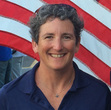Sharing My Enthusiasm: Public Speaking for Private People
As many of you know, I gave a talk at the Annapolis Yacht Club (AYC) recently—and, partly thanks to all of your toasts and best wishes, it was the best one yet. Two weeks later I’m still smiling and newly inspired, just by sharing my own enthusiasms with a lively audience.
I am definitely rusty at public speaking, so I decided to write down 10 “best practices” that might help achieve similar results in the future… or at least avoid a repeat of past mistakes. These timeless truths will ensure that everyone goes home smiling—even speakers who are as self-critical as I am.
 Photo (and microphone use) courtesy of Margaret Podlich1. Say thank you (at least once)
Photo (and microphone use) courtesy of Margaret Podlich1. Say thank you (at least once)It may seem trite, but your host and your audience will still appreciate being thanked. And an omission will stand out. (Thanks again to AYC, Margaret Podlich, and to Sophie Podlich for selling books “like Girl Scout cookies!”)
2. Find a format that helps you relaxFor me, it’s putting together what I still call a “slideshow” (a term much more appealing than a “Powerpoint”), and then using each visual as the spark for what I want to say next. If I rely only on notes, I tend to read them—which is not nearly as much fun for anyone.
3. Give yourself plenty of setup timeWhen I arrived, AYC had already placed two large flat screens either side of a podium with microphone. And as soon as I realized I was missing a critical Mac-friendly adapter, their on-site “techie” came up with one. But at most venues you’ll be the only tech support, and once your audience is in the room it will feel rude to focus on getting your laptop to play nicely with a provided projector. Make sure to show up early enough for distraction-free prep time.
4. Use the microphoneThe evening’s “sponsor” Margaret Podlich is an excellent public speaker, and beforehand she encouraged me to use the provided microphone… but I started off without it, because it seemed like an unnecessary aggravation in a relatively quiet room. When I asked the audience what they preferred, though, the response was immediate: “yes please use the microphone.” And as soon as I switched it on, I could stop worrying about projecting (a nicer word than “yelling”) and instead focus on sharing my knowledge.
5. Focus the talk on your own unique knowledgeFor me, that’s the intersection between books and boats. Sharing what I’d learned about Star history with AYC’s book group and some well-known sailors provoked a very stimulating discussion—and also inspired a few audience members to tell their own stories.
6. Trust your enthusiasmDespite several practice runs of my presentation, about halfway through I found myself “surprised” by one visual… and so flubbed the “natural” transition I’d planned. Nobody in the audience cared (and most probably didn’t notice), because they were already intrigued by the picture itself. A few days later, one of the attendees wrote to tell me: “The Star class was lucky to have you write its Championship story.” Yeah!
7. Nobody likes to ask the first questionI usually try to have a “plant” in the audience to get the Q&A rolling, but I didn’t actually pre-plan anything for the AYC event. So I was very happy when sailing legend Gary Jobson (our sport’s best-known public speaker) stuck his hand up like an eager third-grader as soon as I finished my talk. I was even happier when he complimented 100 Years of Gold Stars!
8. Don’t over-prepareIt’s easy to get too locked into exactly what you’ll say. At one speaking event I’d really like to forget, my oh-so-carefully prepared script no longer seemed appropriate by the time I walked up to the microphone… and yet those words crowded out every other thought in my head. In hindsight, I would’ve been much better off just ad-libbing—a fine example of trusting my enthusiasm.
9. Don’t apologize…for anything, especially the size of the crowd. (This was definitely NOT an issue at the well-attended AYC event.) Set a positive tone, reward the ones who show up, and maybe you won’t even remember afterward those two friends who promised to come but didn’t actually make it.
10. End strongLike any other “story,” it’s very soothing to a live audience if you end with a closing statement almost as obvious as The End. “Thanks for coming” makes a decent backup, but I try to include something more personal. The ending at AYC actually felt a bit flat; I will definitely revise it before my next talk. But thanks to such an engaged audience and that fantastic Q&A, we ended strong anyway.
 Missing from this photo is the table full of Under-30 sailors tucked away in the back right corner. A great crowd, and some couldn’t wait to look at the book! Photo: Sophie PodlichJust Add Enthusiasm
Missing from this photo is the table full of Under-30 sailors tucked away in the back right corner. A great crowd, and some couldn’t wait to look at the book! Photo: Sophie PodlichJust Add EnthusiasmI haven’t even touched on how to create a good talk or attract a crowd. If you’re curious, drop me an email or comment below and I’ll share what works for me. Meanwhile, if you need someone to spice up your next yacht club or book group evening… I do so love sharing my own enthusiasm with a lively audience.
The post Sharing My Enthusiasm: Public Speaking for Private People appeared first on Carol Newman Cronin.



